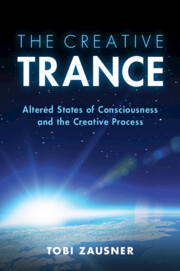Book contents
- The Creative Trance
- The Creative Trance
- Copyright page
- Dedication
- Contents
- Acknowledgments
- Introduction The Pervasive State of Trance
- Chapter 1 The Multifaceted Creative Trance
- Chapter 2 Consciousness and Creativity Theory in the Creative Trance
- Chapter 3 Unconscious Origins of the Creative Trance
- Chapter 4 Empathy and Dissociation in the Creative Trance
- Chapter 5 Evolution, Altered States, and the Creative Trance
- Chapter 6 The Creative Trance and the Brain
- Chapter 7 Dynamics of the Creative Trance
- Chapter 8 Dyslexia, Attention-Deficit Disorder, and the Creative Trance
- Chapter 9 Illness and Transformation in the Creative Trance
- Chapter 10 Different Abilities and the Creative Trance
- Chapter 11 Dementia and the Creative Trance
- Chapter 12 Altered States of a Lifesaving Creative Trance
- References
- Index
Chapter 6 - The Creative Trance and the Brain
Published online by Cambridge University Press: 02 June 2022
- The Creative Trance
- The Creative Trance
- Copyright page
- Dedication
- Contents
- Acknowledgments
- Introduction The Pervasive State of Trance
- Chapter 1 The Multifaceted Creative Trance
- Chapter 2 Consciousness and Creativity Theory in the Creative Trance
- Chapter 3 Unconscious Origins of the Creative Trance
- Chapter 4 Empathy and Dissociation in the Creative Trance
- Chapter 5 Evolution, Altered States, and the Creative Trance
- Chapter 6 The Creative Trance and the Brain
- Chapter 7 Dynamics of the Creative Trance
- Chapter 8 Dyslexia, Attention-Deficit Disorder, and the Creative Trance
- Chapter 9 Illness and Transformation in the Creative Trance
- Chapter 10 Different Abilities and the Creative Trance
- Chapter 11 Dementia and the Creative Trance
- Chapter 12 Altered States of a Lifesaving Creative Trance
- References
- Index
Summary
The mind is the seat of trance. The ways that we think, consciously and unconsciously, shape our creative process and structure its creative trance. Every thought we have, every movement we make, changes the landscape of our brain, producing its own neural signature from the solution of everyday problems to meditations that progress toward transcendent states. With its contradictory styles of thought, creativity has a unique assembly of neural processes not usually found in ordinary cognition, and is associated with the release of dopamine, endorphins, serotonin, and oxytocin, and can be shaped by insight and synesthesia. Cognitive neuroscience reveals the heterogeneity of creative trance states through activation of different brain regions, such as the medial temporal lobe memory network, the prefrontal cortex, both brain hemispheres, and significantly the default mode network, which is associated with divergent thinking and daydreaming. As the Nobel Prize–winning pharmacologist James Black said, “I daydream like mad.”
Keywords
- Type
- Chapter
- Information
- The Creative TranceAltered States of Consciousness and the Creative Process, pp. 80 - 96Publisher: Cambridge University PressPrint publication year: 2022
- 1
- Cited by

